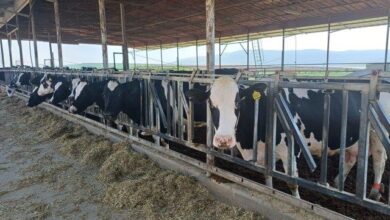Application of Microorganisms to Improve the Composting Products of Sludge Compost

Nativ Rotbart (nativ@gri.org.il) , Asher Maimon, Eyal ben Nevat, Yohana Mertzbach and Yossi Hingel.
1. Introduction
In Israel, domestic sewage effluents are processed in plants to be reused in agriculture. Sludge originates in the solids that sink in the wastewater treatment basins and in the microorganisms that decompose the organic matter in the effluent. The sludge is a waste with high potential for environmental hazards because it has a high concentration of pathogens and disease agents, synthetic materials and sometimes heavy metals (found mainly in industrial effluents). Removing the sludge from the facility must be done with great care, then it can be composted, and then used as a fertilizer for agriculture 1,2.
Compost Or plant, Jordan valley, recycles 75% of sewage sludge produced in Israel. Sludge mixed with plant-based pruning, and via a ‘thermophilic phase’ and a ‘mesophilic phase’ produced high quality compost all year round, while during the winter the process slows down due to the low temperatures 34. EM methodology stated 3 microbial families which reside in any ecological niche: “positive microorganisms” (causes regeneration), “negative microorganisms” (causes degeneration), “opportunistic microorganisms” (causes either regeneration or degeneration). Higa showed that EM can “pull” more of the ‘opportunistic’ to become positive, and by which benefit with that specific niche 5.
The purpose of the experiment was to apply EM in sludge compost and test its effect on the quality, smell, flies presence and duration.
2. Materials and Methods
Sludge with 43-44% moisture content was brought from Compost Or plant to the Shamir research Institute at Katzrin. Samples were divided into two treatments: EM applied (Each liter of sludge, was applied with 2 ml of EM diluted with 20 ml of water) and control with no EM to it at all.

Figure 1. compost piles of EM and control.
During the experiment, the samples did not heat up (i.e. there were no signs of the composting process starting) and piles were enlarged, assuming a volume large enough for the composting process to begin.
After five months, 20 identical 10 liter- pots filled with a substrate from the piles (EM / control). Drain’s EC and pH were measured daily. When the EC dropped below one, Lettuces were planted inside the pots. The plants watered twice a day in the morning 250ml of water. Leachates’ EC and pH leachates were measured weekly. The rest of the piles were sieved for 2mm and were analyzed.
After a month, the Lettuces were removed entirety from the pots roots included, weighed and sent for analysis. Pots bedding were analyzed.
Statistical analysis was performed in Jmp (SAS) – each index was tested for Tukey’s HSD test.
3. Results
Beginning stage weight:- a significant decrease in the weight of all samples was observed probably due to water evaporation, with no significant difference for EM or control.
Beginning stage temperature:EM and control had no significant difference in the temperatures. In addition, pile temperatures remain below 20° C regardless of volume, and samples temperature were lower than greenhouse temperature all along.
Substrate leachate EC: lettuces were planted after EC index was below one. After the planting index dropped steadily and stabilized at 0.54. EM and control had no significant difference.
pH in substrate leachate:pH=7 during the preparation of substrates. During the growing of the lettuces it rose to pH=8 probably due to the relatively alkaline irrigation water. EM and control had no significant difference.
Pile chemical analysis: Leftovers of compost after planting were watered for additional 2 weeks, then sampled and sent for analysis. Significant differences were found: the pile EM average dry weight was 4.28% higher, average electrical conductivity was 18.4% higher, ammonia content was 11% higher, moisture content was 5.3% lower, and nitrate content was higher by 1225% compared to the control. Average ash percentage in EM-pile was significantly lower at 12.2% Vs control. Averages of Organic matter, carbon, nitrogen, and carbon to nitrogen ratio had very small differences between EM and control. Both piles were tested for maturity (Vasper) receiving grade A with negligible difference.
Analysis of the potted substrate: Average sodium in plants grown in EM-substrate significantly reduced by 5.74% Vs control. Salmonella bacterial index was very low in all substrates. Fecal index in the EM-substrate was insignificantly 45% higher Vs control. Potassium in the EM-substrate was insignificantly lower Vs control and the chloride ratio in the EM-substrate was insignificantly 22.22% lower Vs control. Differences in averages of: pH, electrical conductivity, calcium and magnesium, ammonia, nitrate and phosphorus were negligible.

Figure 2. Nitrate concentrations (mg / kg soil) in piles and in the pots’ substrate, after lettuce growing according to the treatments.
Lettuces analysis: Average fresh weight of Lettuces grown in EM-substrate was significantly 26.6% higher and average dry weight was significantly 25.7% greater Vs control. Manganese average was significantly 27% greater in control lettuces. Differences in general nitrogen, phosphorus, potassium iron, zinc, copper, and dry weight were negligible.

Figure 3. Lettuce growing test. Ten replicas of EM applied / control based compost substrate.
 Table 1. Weight results (fresh and dry) of the Lettuce plants who were planted in compost with and without EM application. Averages with standard errors. Both parameters are significant.
Table 1. Weight results (fresh and dry) of the Lettuce plants who were planted in compost with and without EM application. Averages with standard errors. Both parameters are significant.
4. Discussion
At the beginning of the experiment, weight of the piles has decreased, which can be explained by dehydration of the piles following evaporation. Overall, the fresh and dry weight of the plants grown in the EM-treated substrate was significantly larger (25.7% on average and 26.6%, respectively) relative to the control, indicating that the EM bacteria probably had some effect on the substrate that we were unable to detect during the experiment. We recommend testing the leaf vitality by examining the amount of chlorophyll using a spectrophotometer. The identity of the microbial population and its metabolic functions should also be considered for filling gap.
The amount of nitrate in the piles treated with EM is 1225% greater than in the control and in the potting substrate after growth, there is no great difference between the amounts of nitrate. We therefore hypothesize that the nitrate is absorbed by the lettuce and caused a significant difference in its weight. Nitrogen forms in substrates to see if EM bacteria cause further changes in this context.
Furthermore, A. El-Shafei et al.6 stated that EM could increase the acidity of the substrate, the amount of minerals available to the plant by producing chelates, and the absorption of water and thus increase the quality and weight of the plant. Treated with EM, clots formed that facilitated the nutrient uptake and / or the lactobacilli in EM formed colonies with lactic acid near the rhizosphere of the lettuce and thus caused a slight change in pH (which could not be tested by existing means) that helped it absorb nutrients. These hypotheses should be inquired in further experiments.
All substrates underwent fecal and bacterial quantification and no abnormal pathological findings of bacteria were found in the substrates.
Accordingly, the minimum volume of the compost pile for efficient retention of heat, which activates microorganisms, is 37.8 liters. (Our piles were larger) still failed to accumulate heat and were colder than the ambient temperature throughout the measurements. Apparently, inside piles of sewage sludge there is ventilation, shade and insulation that does not keep heat. In addition, massive evaporation of water also causes heat loss because the water takes heat from the environment with it during evaporation, so in subsequent experiments it is necessary to find a solution on how to keep the piles moist without causing evaporation decreasing their temperatures.
Vasper maturityanalysis showed maturity grade of A.i.e. the two piles underwent process of decomposition without accumulating heat. Apparently, heat accumulation should not be the only indication of the sludge composting process.
We would like to thank our partners, Or recycling park, EM Israel and Tel-Hai college.
Refences




